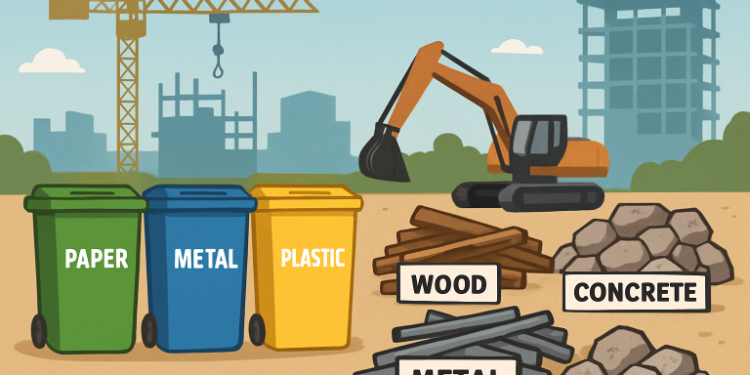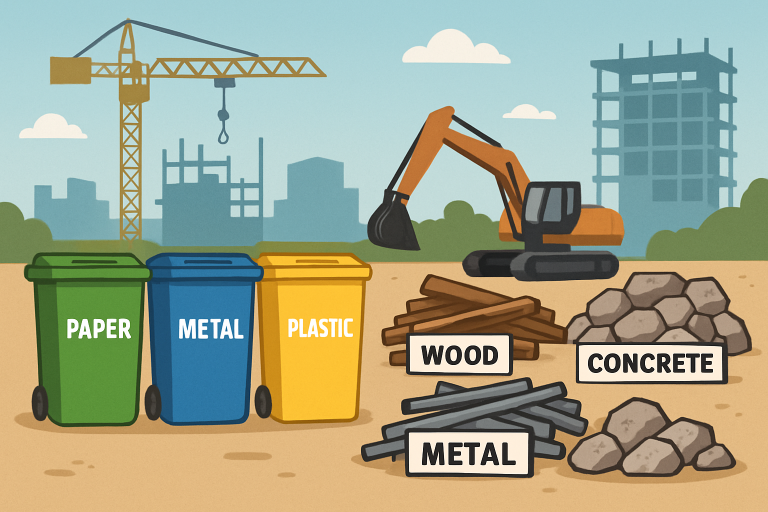Think Before You Toss: Smart & Creative Ways to Cut Down Construction Waste

Table of Contents
- 1 Introduction
- 2 Design for Disassembly
- 3 Embrace Prefabrication and Modular Construction
- 4 Implement Building Information Modeling (BIM)
- 5 Adopt Just-in-Time Material Delivery
- 6 Establish On-Site Recycling Programs
- 7 Utilize Sustainable and Recycled Materials
- 8 Leverage Digital Tools for Waste Management
- 9 Train and Educate Construction Teams
Introduction
Construction waste is a major global issue, causing resource depletion and environmental problems. Millions of tons of debris, off-cuts, packaging, and surplus materials end up in landfills annually. Innovative waste management strategies can help reduce this, promoting a more sustainable and responsible industry. Services like Dumpster Rental Services can help organize site waste and maximize recycling efforts, segregating recyclable and non-recyclable materials at the source. This not only reduces environmental impact but also disposal costs. With increasing regulations and demands for greener buildings, professionals must employ methods to decrease waste volume throughout construction projects. Creative solutions include rethinking building designs and leveraging technologies like digital modeling and project management apps. Implementing innovative waste-reduction measures is not just about cost savings but also a step towards a cleaner, greener industry.
Design for Disassembly
Design for disassembly is a design approach that encourages architects and builders to construct buildings with the future in mind. This approach involves using connections, fasteners, and materials that allow for easy dismantling and reuse of buildings, rather than demolition. This technique facilitates future renovations, repairs, and relocations, and allows for easy recycling or reuse of components. One notable project using this approach is the Waste House at the University of Brighton, where 90% of materials were recycled. This approach helps divert waste from landfills and promotes a more circular economy. As more designers adopt this mindset, buildings transition from one-time-use constructions to adaptable resources.
Embrace Prefabrication and Modular Construction
Prefabrication and modular building methods reduce waste by manufacturing components in controlled factory settings before transporting them to the job site. This approach leads to greater precision, less material excess, and efficient assembly, as defects can be detected and corrected before shipping. Prefabrication can cut on-site waste by up to 15%, making it a popular choice for builders. It also speeds up project timelines, eliminates weather-related construction delays, and reduces the environmental footprint of building sites.
Implement Building Information Modeling (BIM)
Building Information Modeling (BIM) is a technology that provides detailed three-dimensional modeling of projects before they’re built. It creates accurate digital blueprints, allowing teams to visualize every aspect of a project and predict material needs, reducing waste and over-ordering. BIM models also detect clashes, resolving issues before materials are purchased and labor is scheduled. It improves coordination among designers, engineers, and contractors, ensuring material efficiency throughout a building’s lifecycle. BIM also supports future renovations and deconstruction, providing detailed records for easier recycling and reuse.

Adopt Just-in-Time Material Delivery
Just-in-Time (JIT) delivery is a supply chain management technique used in construction to ensure materials arrive as needed, reducing on-site storage time and reducing damage, spoilage, and theft. It reduces overstocking, material quality decline, and excess packaging waste. JIT requires careful scheduling and good supplier relationships, but its advantages in waste reduction and site productivity make it a wise choice for modern construction projects. Proper execution contributes to a safer, more organized site and reduces disposal costs due to ruined inventory.
Establish On-Site Recycling Programs
On-site recycling stations and clear signage for various materials can improve efficiency and compliance during construction projects. Simple strategies like reminders, color-coded dumpsters, and regular check-ins can improve compliance. Partnering with local processing plants can divert waste from landfills. On-site recycling is an effective way to lower construction and demolition waste rates, according to the U.S. Environmental Protection Agency. Making recycling part of daily routines shows progress towards sustainability goals and educates workers about responsible waste management.
Utilize Sustainable and Recycled Materials
Recycling and sustainable products like reclaimed lumber, recycled steel, and low-impact concrete reduce dependency on finite resources and keep usable materials out of waste streams. Innovations make it easier for builders to select environmentally friendly options, such as insulation made from recycled denim and composite panels made from agricultural waste. Post-consumer waste materials, such as denim insulation and engineered wood products, can also be repurposed, transforming waste into valuable building supplies. Opting for local or renewable materials reduces transportation emissions and supports regional economies, and can help achieve green building certifications.
Leverage Digital Tools for Waste Management
Digital waste tracking software provides real-time data on material usage, loss, and recycling rates, enabling project managers to improve waste management plans, set benchmarks, and maintain transparency. Customized cloud-based tools can identify inefficiencies and new waste reduction opportunities. Some systems can automate reporting to building owners, city officials, or sustainability certifications, reducing administrative burdens and ensuring data is not overlooked in waste reduction efforts.
Train and Educate Construction Teams
Continuous education for construction crews is crucial for understanding waste reduction goals and methods. Regular training sessions and toolbox talks foster a culture of sustainability, accountability, and daily material conservation opportunities. This approach fosters a shared sense of purpose, leading to creative problem-solving, improved morale, and better long-term outcomes for projects and the environment. Embracing an innovative approach to construction waste reduction, utilizing methods like disassembly design, modular construction, BIM, and sustainable sourcing, and integrating site-specific solutions like on-site recycling, can lead to environmental stewardship and project efficiency. This approach not only brings the industry closer to sustainability targets but also builds community trust, boosts operational efficiency, and saves money.






